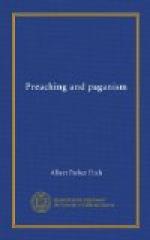One of them is by paying intelligent attention to the physical surroundings of the worshiper. The assembly room for worship obviously should not be used for other purposes; all its suggestions and associations should be of one sort and that sort the highest. Quite aside from the question of taste, it is psychologically indefensible to use the same building, and especially the same room in the building, for concerts, for picture shows, for worship. Here we at once create a distracted consciousness; we dissipate attention; we deliberately make it harder for men and women to focus upon one, and that the most difficult, if the most precious, mood.
For the same reason, the physical form of the room should be one that does not suggest either the concert hall or the playhouse, but suggests rather a long and unbroken ecclesiastical tradition. Until the cinema was introduced into worship, we were vastly improving in these respects, but now we are turning the morning temple into an evening showhouse. I think we evince a most impertinent familiarity with the house of God! And too often the church is planned so that it has no privacies or recesses, but a hideous publicity pervades its every part. We adorn it with stenciled frescoes of the same patterns which we see in hotel lobbies and clubs; we hang up maps behind the reading desk; we clutter up its platform with grand pianos.
It is a mere matter of good taste and good psychology to begin our preparation for a ministry of worship by changing all this. There should be nothing in color or ornament which arouses the restless mood or distracts the eye. Severe and simple walls, restrained and devout figures in glass windows, are only to be tolerated. Descriptive windows, attempting in a most untractable medium a sort of naive realism, are equally an aesthetic and an ecclesiastical offense. Figures of saints or great religious personages should be typical, impersonal, symbolic, not too much like this world and the things of it. There is a whole school of modern window glass distinguished by its opulence and its realism. It ought to be banished from houses of worship. Since it is the object of worship to fix the attention upon one thing and that thing the highest, the room where worship is held should have its own central object. It may be the Bible, idealized as the word of God; it may be the altar on which stands the Cross of the eternal sacrifice. But no church ought to be without one fixed point to which the eye of the body is insensibly drawn, thereby making it easier to follow it with




